The bowline knot is one of the most iconic and useful knots in various activities including sailing, climbing, and rescue operations. Known for its strength, reliability, and ease of untying even after being subjected to a heavy load, the bowline creates a fixed loop at the end of a rope. The knot is tied by forming a small loop (often called the “rabbit hole”) followed by passing the free end of the rope (the “rabbit”) through the loop, around the standing part of the rope, and back down through the loop. This technique ensures that the bowline is secure yet easy to untie when necessary.
History of the Bowline
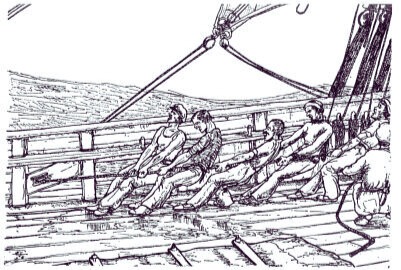
The bowline knot is revered for its ancient origins and pivotal role in maritime and climbing activities. Its history likely stretches back hundreds of years, possibly originating in the maritime traditions of early sailors. The bowline’s primary function was to create a secure loop at a rope’s end, crucial for sailing operations such as fastening sails to the bows of ships—hence the name “bowline.” The first documented reference to the bowline appears in the 17th century in John Smith’s journals, highlighting its long-standing utility and importance. Over the centuries, the bowline has maintained its relevance due to its unique combination of simplicity, strength, and ease of untying, making it indispensable in both historical and modern practical applications.
Characteristics of a Bowline
Strength
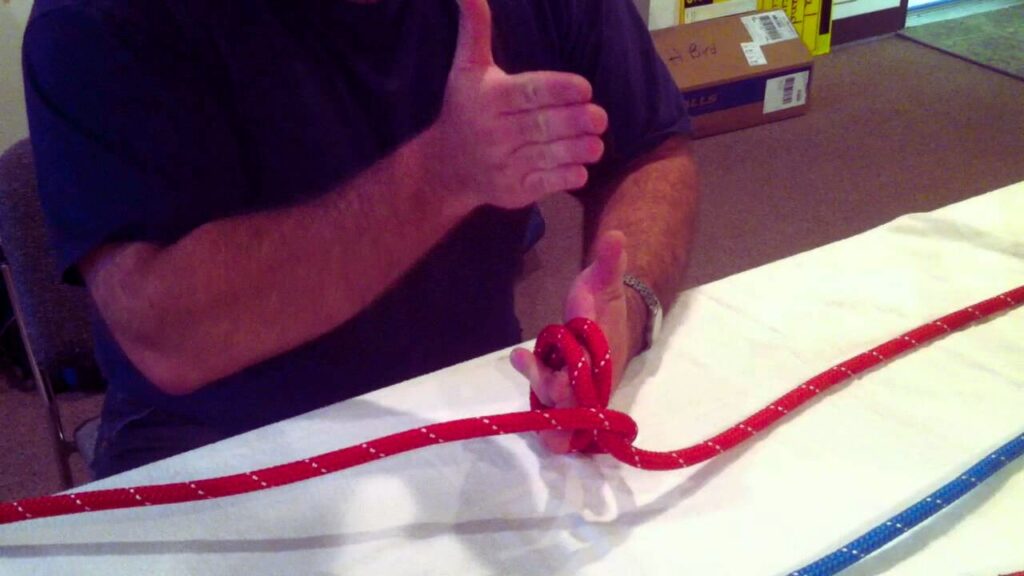
The bowline is renowned for its strength and reliability in various applications, notably in climbing and sailing. The knot’s strength primarily derives from its design, which effectively distributes stress along the loop and standing part of the rope. Pull tests have shown that the bowline retains a high percentage of the rope’s inherent strength. Specifically, it breaks at about 62% of the rope’s maximum load capacity. This strength, combined with the ease of tying and untying, even under load, makes the bowline a preferred choice in situations where a secure loop is necessary. The knot’s efficiency and durability are well-documented, underscoring its continued use in safety-critical activities such as sailing and climbing.
Security
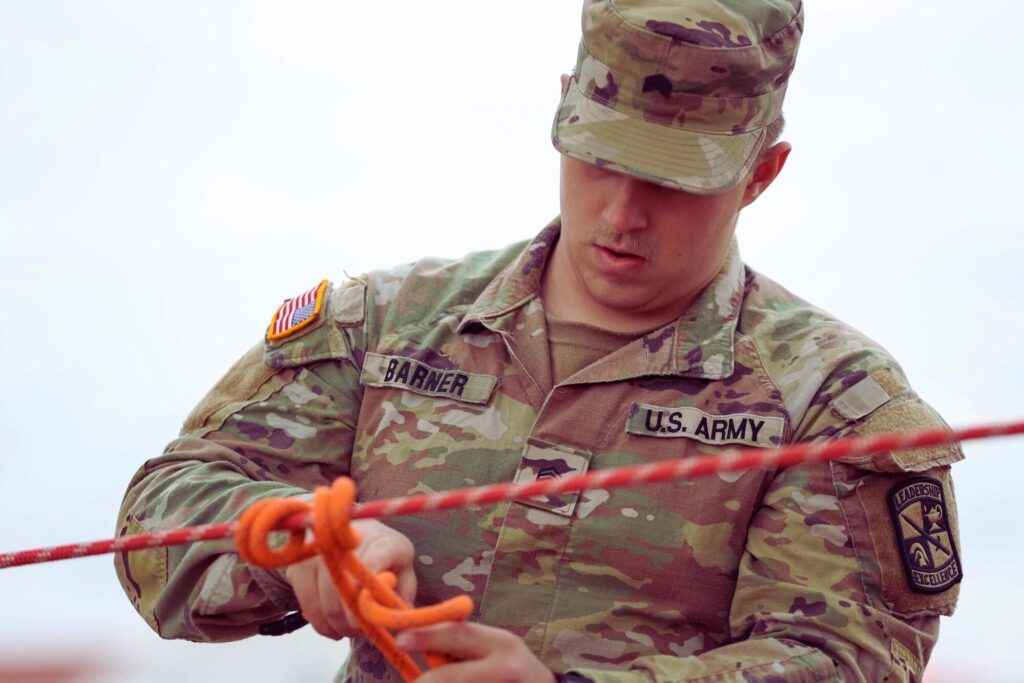
The bowline is generally recognized for its robustness and reliability; however, its security is a topic of debate, particularly under certain conditions. The bowline is inherently secure in many variations, meaning it does not need additional knots to maintain its structure under normal conditions. However, its main drawback is a tendency to loosen when not under load, especially with cyclic loading and unloading, which can compromise its integrity. In climbing, the double bowline and other variations are tested for security by simulating repeated tension to ensure they remain fastened. While some climbers trust its security when properly tied, it’s often recommended to use knots like the rethreaded figure eight for consistent security across varying conditions, particularly where uniform tying methods are crucial.
Versatility
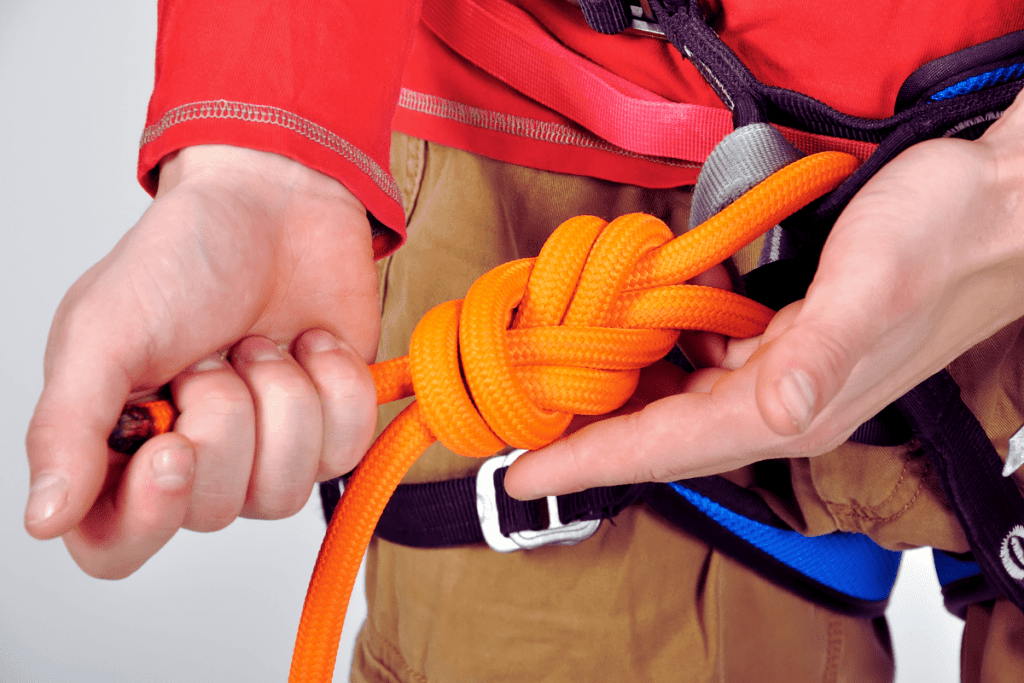
The bowline is highly regarded for its versatility and reliability in various situations. Its primary function is creating a fixed loop that can handle significant loads without slipping, which is particularly useful in scenarios where secure, non-tightening loops are needed:
- Outdoor Activities: Often used by campers and hikers to secure tents, tarps, and other gear. It is also a favorite among rock climbers for safely tying into harnesses for climbing.
- Marine Use: The bowline is traditionally used in boating to fasten sails and secure lines, where quick release under load is necessary.
- Rescue Operations: Ideal for rescue applications because of the speed with which it can be tied and its ability to form a secure loop that can be easily placed around persons or objects.
- Everyday Tasks: Commonly used to lash down loads on trailers or trucks, ensuring that items remain secure during transport.
This knot’s adaptability and ease of untying even after bearing a heavy load make it a fundamental skill for anyone frequently working with ropes.
How to Tie a Bowline
Step-by-Step Guide

The bowline knot creates a fixed loop at the end of a rope and is known for its strength and reliability. Here’s a step-by-step guide to tying a bowline knot:
- Make a Small Loop: Lay the rope across your hand with the free end hanging down. Make a small loop in the standing part of the rope (the long side). This is sometimes called the ‘rabbit’s hole’.
- Pass the Free End Through the Loop: Take the free end (the ‘rabbit’) and pass it up through the loop from underneath.
- Wrap Around the Standing End: Wrap the free end around the standing part of the rope, going from front to back.
- Back Down Through the Loop: Bring the free end back down through the loop (the ‘rabbit’ going back into the hole).
- Tighten the Knot: Pull on the free end while holding the standing part to tighten the knot. Make sure the knot is secure and the loop size does not change.
The bowline knot is not only secure, strong, and reliable but also easy to untie after being loaded.
Tips and Tricks
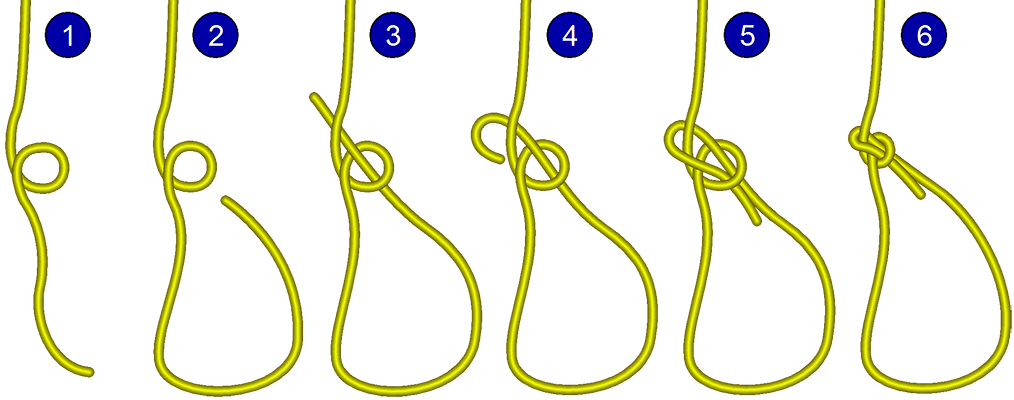
Perfecting the bowline knot involves understanding its applications and ensuring safety, especially in critical uses such as climbing. Here are some expert tips:
- Practice in Varied Conditions: Practice tying a bowline in different conditions, including in the dark, to ensure you can tie it under any circumstances.
- Use a Safety Knot: Always tie a safety knot with the bowline when climbing to prevent it from shaking loose. A double overhand knot near the loop end can serve this purpose.
- Check Your Knot: After tying, always double-check your knot to ensure it is correctly made and secure. This is crucial in climbing where the bowline is used for tying in.
- Learn Variations: Understand and practice variations like the running bowline for situations where you need a loop that can tighten around an object.
- Study Jam Resistance: In situations where the knot needs to resist jamming, like anchoring, learning specific versions such as Scott’s locked bowline can be beneficial.
Common Uses of the Bowline
Boating and Sailing

The bowline knot holds a pivotal role in boating and sailing due to its reliability and versatility. Here’s why it is so important:
- Forms a Secure, Fixed Loop: The bowline creates a strong, fixed loop at the end of a line, which does not slip under tension. This feature is essential for tasks that require a secure point of attachment without the risk of the knot tightening under load.
- Ease of Tying and Untying: Despite its strength, the bowline is relatively easy to tie and more importantly, to untie, even after being subjected to a significant load. This makes it very practical for sailors who may need to release a knot quickly.
- Versatility in Usage: It is used for a myriad of purposes such as securing sails, attaching lines to boats, and ensuring that equipment is tied down securely during navigation.
- Historical Significance: The bowline has been a staple in sailor’s knot repertoires for centuries, indicative of its effectiveness and essential role in marine operations.
- Non-slip Nature Under Load: It is particularly valued for its ability to form a loop that does not tighten under strain, which is crucial in sailing applications where knots need to maintain their structure and function under varying loads.
Climbing

The bowline knot is a significant tool in climbing and mountaineering due to its unique properties and historical usage:
- Historical Usage: Originally a maritime knot, the bowline has been adapted for climbing due to its efficiency in forming a fixed loop. It’s been in use for centuries, although its use in climbing is relatively more recent and somewhat uncommon compared to other knots.
- Strength and Safety: The bowline knot is valued for its strength and the ability to tie and untie easily, even after bearing a load. However, it’s important to note that a bowline can reduce a rope’s strength by about 25 to 30 percent, which is a consideration climbers must account for compared to other knots like figure eight, which reduces strength by only 20 to 25 percent.
- Ideal for Alpine Climbing: Particularly in alpine climbing, the bowline is preferred for scenarios where the climber is less likely to fall, due to its ease of tying and untying. This feature makes it suitable for fast-paced or emergencies where adjusting the knot quickly is beneficial.
- Use in Climber’s Arsenal: Despite its drawbacks, the bowline is considered a valuable knot to know for every climber because of its utility in creating secure, non-slipping loops that are essential in various climbing setups.
Rescue Operations
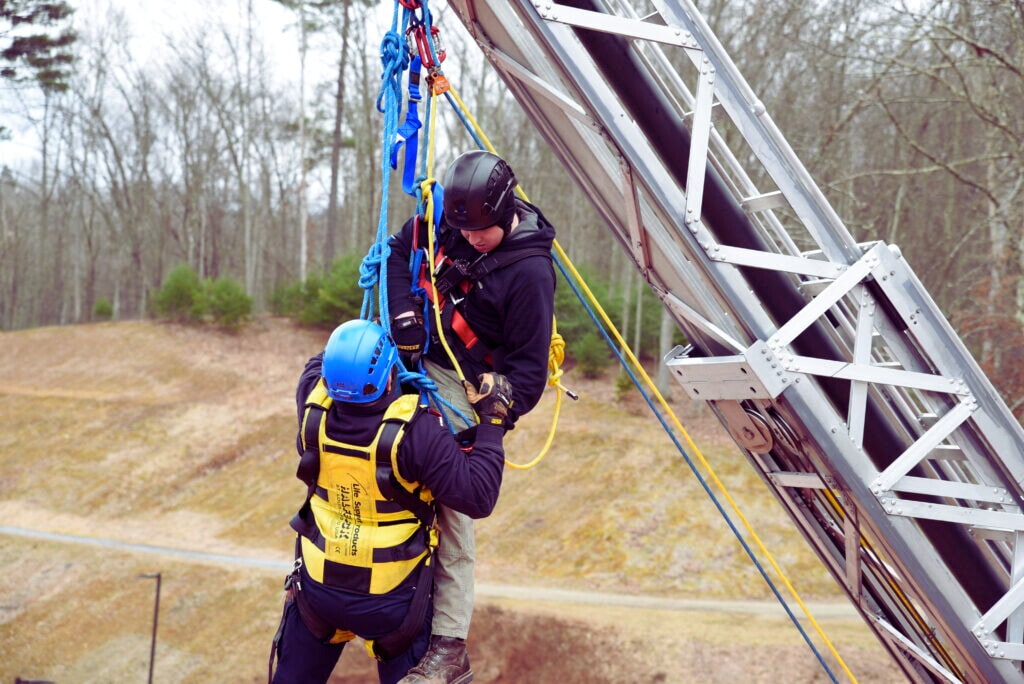
The bowline knot plays a crucial role in rescue operations due to its versatility and reliability:
- Adjustable Gain: The bowline is preferred in rescue operations for its ability to adjust its gain, meaning it can be tightly secured with minimal slack, which is advantageous in rescue scenarios where precision is critical.
- Creating Loops: The Spanish Bowline variant is specifically used in search and rescue to create two stable loops that can be used to securely tie around a person’s legs, facilitating safe and effective lifting and lowering during rescues.
- General Utility: While the bowline is not rated for life safety on its own in some contexts (such as certain firefighting operations where a double figure 8 might be preferred), it is still widely used for hauling equipment and other non-life safety applications in rescue settings.
- Training and Skill Development: Firefighters and other rescue personnel are trained to tie a bowline knot as part of their essential skill set, indicating its importance and frequent use in various rescue scenarios.
Variations of the Bowline
Double Bowline

The double bowline is a variation of the classic bowline knot, providing additional security and strength. It involves an extra turn around the loop compared to the standard bowline. This modification allows for a more substantial loop and offers better load distribution, which can be crucial in climbing and rescue scenarios:
- Structure: The double bowline features two turns around the standing part of the rope instead of one, resulting in a larger and stronger loop.
- Strength and Safety: It is considered to be technically stronger than a single bowline, important in situations where the breaking strength of the knot could be a factor. When tied correctly, the double bowline maintains its stability and strength even under the weight of a fall, without the risk of fusing under load.
- Uses in Rescue: In rescue and recovery, a variation known as the bowline on a bight can create multiple loops for securing a person more effectively, enhancing its utility in critical scenarios.
Water Bowline
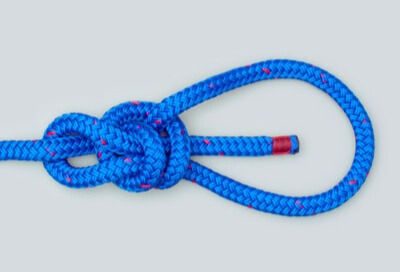
The Water Bowline is a variation of the classic bowline knot, known for its enhanced security and stability, especially in wet conditions. This variant involves an additional twist compared to the standard bowline, which helps maintain its shape and strength even when subjected to continuous water exposure:
- Tying the Knot: To tie a Water Bowline, the process typically begins by forming a clove hitch before completing the bowline itself. The end of the rope is threaded up, around, and then down through the loop created by the clove hitch.
- Applications: The Water Bowline is particularly useful in maritime activities where ropes are frequently exposed to water. Its structure ensures the knot remains secure and easy to untie, even when wet, making it ideal for marine use.
Yosemite Bowline

The Yosemite Bowline is a modified version of the traditional bowline knot, offering enhanced security. It is particularly popular among climbers for tying into a harness because it maintains the general ease of tying and untying characteristic of a bowline but with additional security:
- Structure: The Yosemite Bowline adds an extra wrap of the free end around one leg of the loop before finishing the knot. This extra step helps secure the tail, reducing the risk of the knot inadvertently coming undone.
- Usage: Due to its secure nature, the Yosemite Bowline is recommended for climbing applications where safety is paramount. Its security makes it a preferred choice for harness attachments among climbers who favor bowline knots.
- Advantages: The knot’s robustness against untying makes it valuable in scenarios involving repetitive movement and load, such as climbing, where knots can be subject to dynamic stress.
Myths and Misunderstandings
The bowline knot, often celebrated for its robustness and ease of untying, is also subject to several myths and misunderstandings:
- Myth of Increased Security with Double Bowlines: It’s a common belief that a double bowline is more secure than the standard single bowline. However, this isn’t always the case. The security of a bowline, double or single, depends significantly on how well it is tied and set.
- Misunderstanding About Safety Knots: There’s a notion that a ‘safety knot’ should always back up your main climbing knot, like a figure-8 follow-through when tying into a harness. This concept is not universally accepted as necessary; the requirement for such a backup varies based on conditions and personal or institutional safety standards.
- Misconception About Bowline Reliability: Some fear that the bowline is inherently unsafe because it can capsize or come undone if not properly tied or under certain conditions. While true that improper tying can lead to failures, a correctly tied and dressed bowline is generally secure.
Understanding these myths helps clarify the bowline’s appropriate applications and emphasizes the importance of correct knot-tying practices.
Maintaining Your Knot Skills
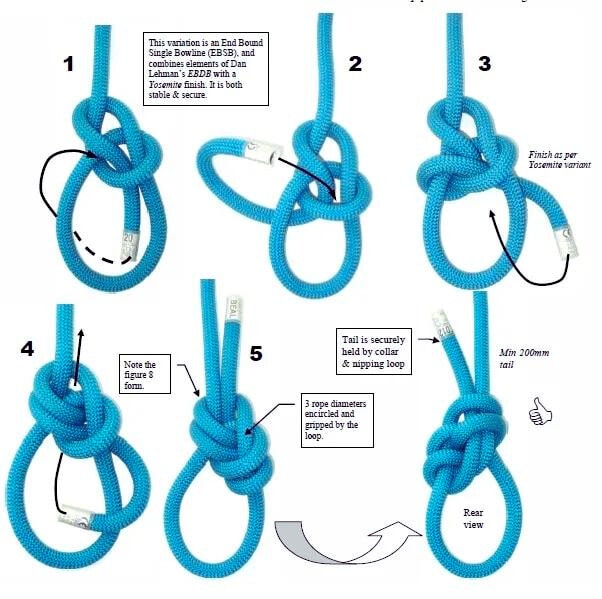
To keep your bowline-tying skills sharp, consider the following practices:
- Regular Practice: Like any skill, regular practice is crucial. Repeatedly tie the bowline in different conditions and with various types of ropes to enhance muscle memory and adaptability.
- Step-by-Step Review: Break down the bowline tying process into steps and practice each step carefully. This ensures that you understand each component of the knot and its function, which improves overall tying efficiency and safety.
- Learning from Visual Aids: Utilize video tutorials, such as those found on YouTube, to see different methods of tying a bowline. This can provide new perspectives and techniques that might be easier or more effective depending on the situation.
- Knot Tying Sessions: Participate in or organize regular knot-tying sessions with peers. This not only provides practice but also allows for feedback and shared learning experiences.
- Use in Practical Situations: Apply the bowline knot in practical situations like camping, boating, or climbing. Real-world applications reinforce the learning and understanding of when and how to use the knot most effectively.
Regular practice and application, along with learning from various resources, will ensure that your bowline-tying skills remain sharp and reliable.
Bowline Knot: Advantages and Disadvantages
The bowline knot is renowned for its effectiveness in various practical applications. Here’s a breakdown of its advantages and disadvantages:
Advantages:
- Reliability: The bowline forms a secure loop that does not slip or tighten under load, making it incredibly reliable for critical uses such as climbing and rescuing.
- Ease of Tying and Unloading: It can be quickly tied and just as quickly undone, even after bearing significant weight.
- Versatility: The bowline is used in sailing, fishing, and camping, demonstrating its versatility across various fields.
Disadvantages:
- Security Concerns: Under cyclic loading (repeated tension and release), the bowline can loosen, which might lead to safety issues in some scenarios.
- Complexity for Beginners: While not the most complex knot, the bowline can be challenging for beginners to learn and remember how to tie correctly.
Overall, while the bowline knot offers several beneficial attributes, its use should be assessed according to the specific conditions and requirements of the task at hand.
Conclusion
The bowline has earned its place as a quintessential knot due to its robustness, versatility, and ease of use. Whether you’re a sailor, climber, rescuer, or just an enthusiast, mastering this knot is a skill that will serve you well throughout life.
Read also: What Does Alchemy mean




